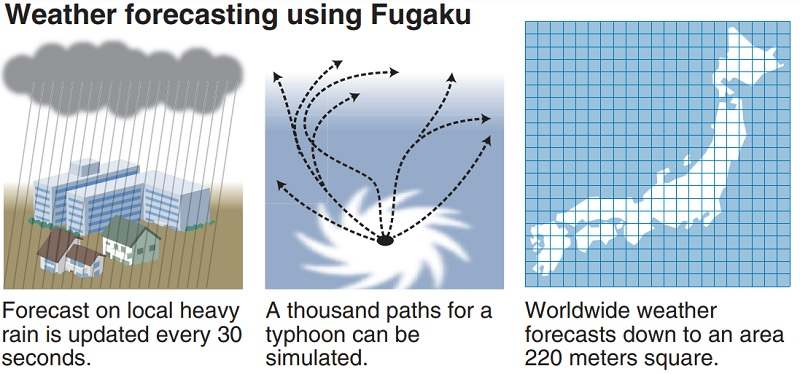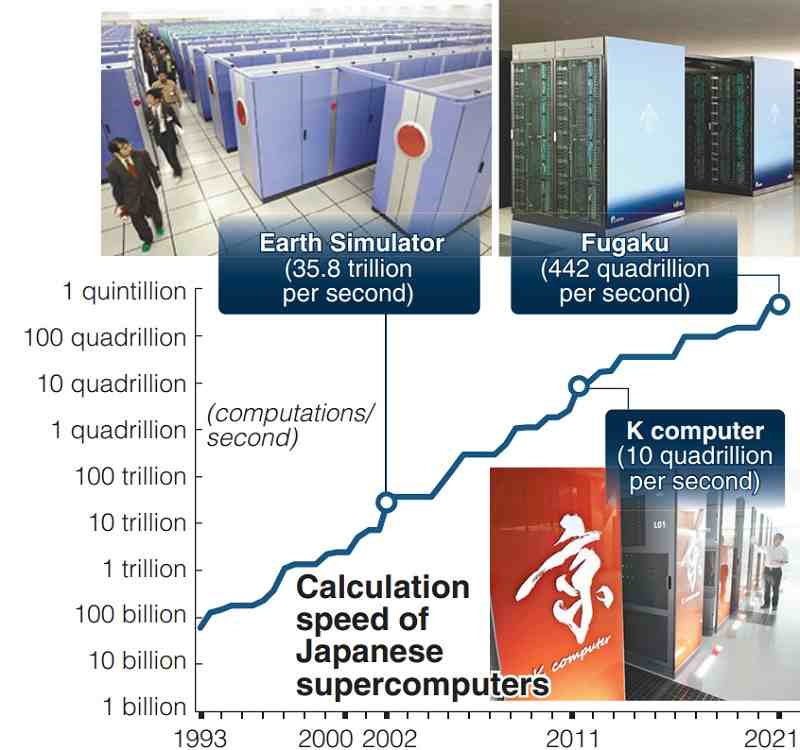
An illustration : Weather forecasting using Fugaku
17:19 JST, October 8, 2021

Syukuro Manabe
Syukuro Manabe, a cowinner of the 2021 Nobel Prize in Physics, is not only a meteorologist but also a contributor to the development of a domestic supercomputer in the 1990s.
His contribution is now linked to the Fugaku supercomputer, the world’s fastest, developed by Japanese research institute Riken.
In the past, weather maps were generally based on observations of clouds and atmospheric pressure. Manabe thought of creating formulas to numerically predict the flows of the Earth’s atmosphere and oceans based on the laws of physics.
For this project, a high-speed computer was essential. Manabe, 90, has made use of computers in the United States since the 1960s to publish his papers. He gained a reputation as “the man who made the world’s most extravagant use of computers.”
In the late 1990s, the then Science and Technology Agency approached Manabe to ask for his help in developing the world’s fastest supercomputer. Manabe returned to Japan in 1997 and joined the development project as a leading expert on climate modeling. Earth Simulator, a supercomputer developed through the project, was the fastest supercomputer in the world for five consecutive six-month terms in 2002-04, enabling scientists to comprehend rainfall distribution and ocean currents in detail on a global scale.
Japan Agency for Marine-Earth Science and Technology Fellow Taro Matsuno, who was one of the development project’s leaders, said, “This is a result of responding to Manabe’s request to accurately predict the future.”
Since then, Japanese supercomputers have been developed with the aim of achieving the world’s best performance. The K computer operated by Riken from 2011 was the world’s fastest for two consecutive terms, and the supercomputer Fugaku that began operating from 2020 has been the world’s fastest for three consecutive terms.

An illustration : Calculation speed of Japanese supercomputers Calculation speed of Japanese supercomputers
Fugaku performs over 442 quadrillion computations per second, making it about 12,000 times faster than the Earth Simulator’s 35.8 trillion calculations in 2002. Researchers using Fugaku aim to divide the entire world into sections just 220 meters square and generate specific weather predictions for each of them, using data from satellites equipped with high-performance radar.
Supercomputers are also used to calculate disaster risks such as heavy rains and floods.
"Society" POPULAR ARTICLE
-

M4.9 Earthquake Hits Tokyo, Neighboring Prefectures
-

Israeli Tourists Refused Accommodation at Hotel in Japan’s Nagano Pref., Prompting Protest by Israeli Embassy and Probe by Prefecture
-

M7.5 Earthquake Hits Northern Japan; Tsunami Waves Observed in Hokkaido, Aomori and Iwate Prefectures
-

Tsukiji Market Urges Tourists to Avoid Visiting in Year-End
-

M5.7 Earthquake Hits Japan’s Kumamoto Pref., Measuring Upper 5 Intensity, No Tsunami Expected
JN ACCESS RANKING
-

Keidanren Chairman Yoshinobu Tsutsui Visits Kashiwazaki-Kariwa Nuclear Power Plant; Inspects New Emergency Safety System
-

Imports of Rare Earths from China Facing Delays, May Be Caused by Deterioration of Japan-China Relations
-

University of Tokyo Professor Discusses Japanese Economic Security in Interview Ahead of Forum
-

Tokyo Economic Security Forum to Hold Inaugural Meeting Amid Tense Global Environment
-

Japan Pulls out of Vietnam Nuclear Project, Complicating Hanoi’s Power Plans





















